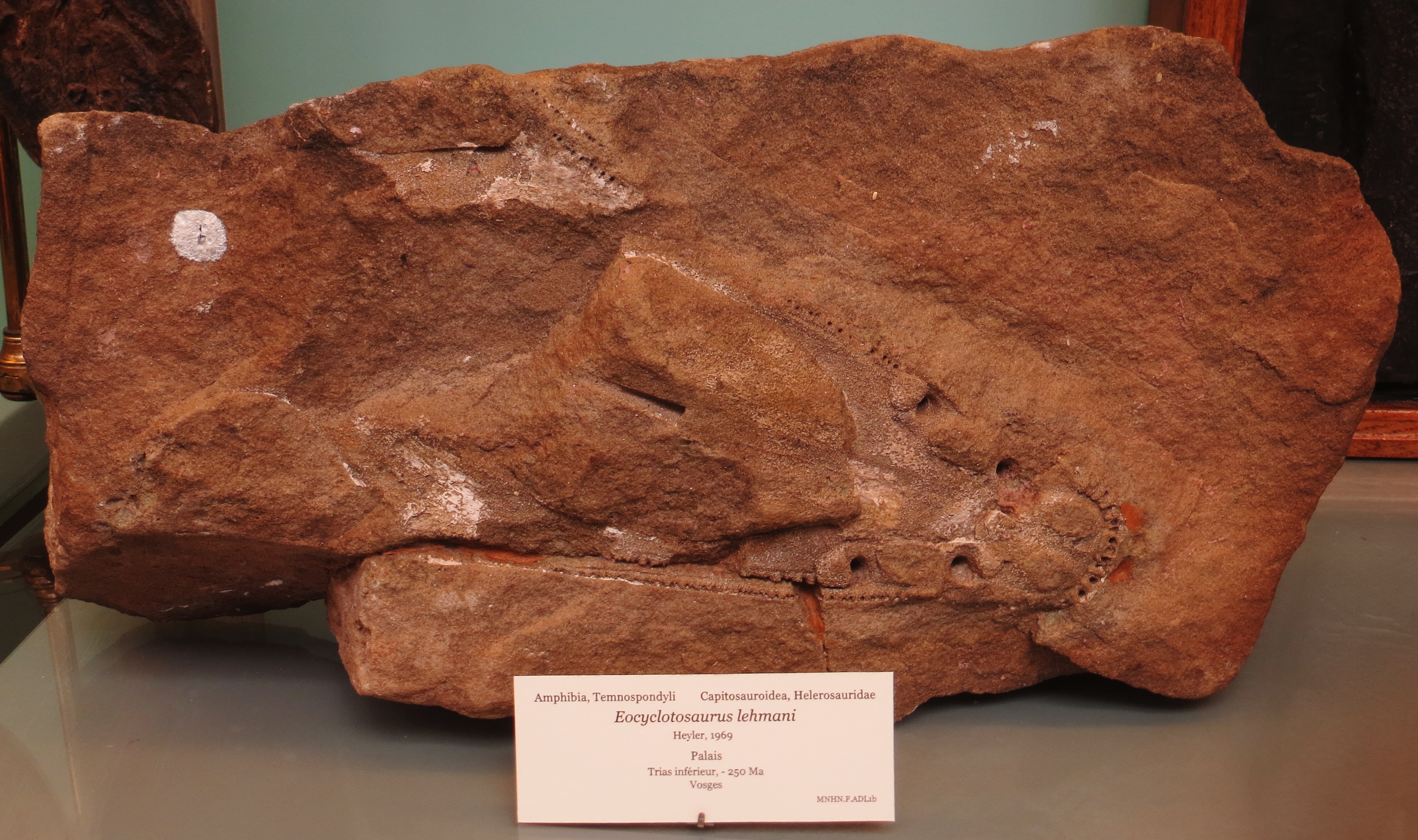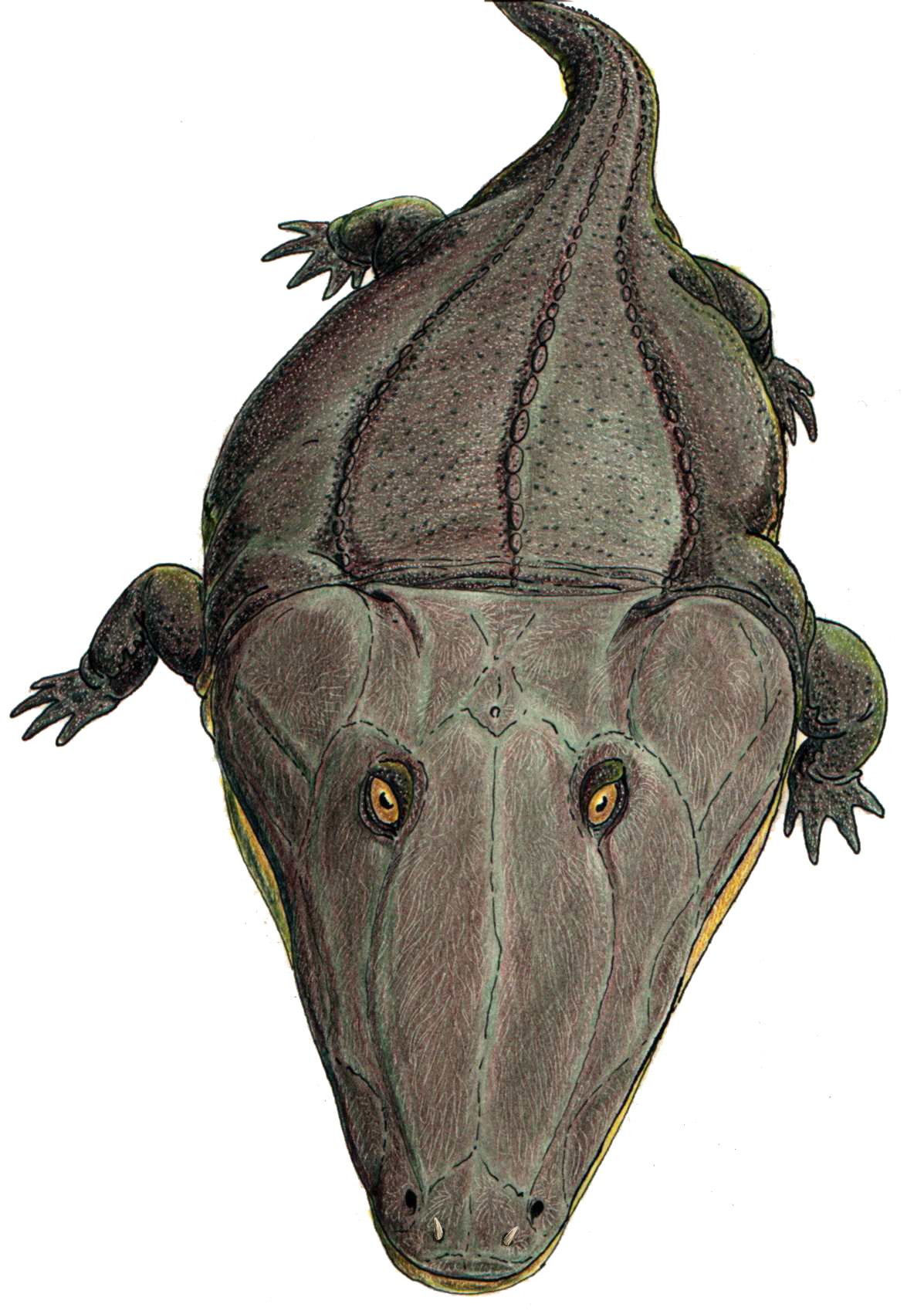|
Tatrasuchus Wildi
''Tatrasuchus'' is an extinct genus of temnospondyl from the Middle Triassic of Poland and Germany. It is classified as a member of the family Cyclotosauridae or Mastodonsauridae. It is closely related to the genus '' Cyclotosaurus''. The type species, ''Tatrasuchus kulczyckii'', was named in 1996. Damiani (2001) considered genus ''Kupferzellia'' Schoch (1997) from the Middle Triassic of Germany to be a junior synonym of ''Tatrasuchus'', and recombined its type species, ''K. wildi'' as the second species of ''Tatrasuchus''. This classification was followed by some authors, e.g. Fortuny ''et al.'' (2011); other authors, e.g. Schoch (2008), maintain ''Tatrasuchus'' and ''Kupferzellia'' as distinct genera. However, Schoch & Moreno (2024) synonymized the two genera, maintaining ''T. wildi'' as a distinct species from ''T. kulczyckii''. Phylogeny Below is a cladogram A cladogram (from Greek language, Greek ''clados'' "branch" and ''gramma'' "character") is a diagram used in cladis ... [...More Info...] [...Related Items...] OR: [Wikipedia] [Google] [Baidu] |
Teresa Maryańska
Teresa Maryańska (1937 – 3 October 2019) was a Polish paleontologist who specialized in Mongolian dinosaurs, particularly pachycephalosaurians and ankylosaurians. She is considered not only as one of Poland's but also one of the world's leading experts on dinosaurs. Career Initially, Mary's studies were regarding invertebrate paleontology. However, she became a member of the 1964, 1965, 1970, and 1971 Polish–Mongolian expeditions to the Gobi Desert, and changed her focus. She described many finds from these fossils, often with Halszka Osmólska. In 1974, Maryanska and Halszka Osmólska were among the first "women to describe new kinds of dinosaurs". Since 1961, Maryańska was affiliated with the Muzeum Ziemi of the Polska Akademia Nauk and was vice-director there from 1976 to 2006, when she retired. Some of the dinosaurs she described: * '' Homalocephale'' (1974), with Halszka Osmólska * ''Prenocephale'' (1974), with Halszka Osmólska * '' Tylocephale'' (1974), with ... [...More Info...] [...Related Items...] OR: [Wikipedia] [Google] [Baidu] |
Capitosauria
Capitosauria is an extinct group of large temnospondyl amphibians with simplified stereospondyl vertebrae. Mainly living as piscivores in lakes and rivers, the Capitosauria and its sister taxon Trematosauria were the only major labyrinthodonts that existed during the Mesozoic in ecological niches broadly similar to those of modern crocodiles, and some grew to very large sizes. At 6 meters in length, the Mid-Triassic '' Mastodonsaurus giganteus'' is not only thought to have been the largest capitosaur, but possibly also the largest amphibian to have lived. The latest known remains are from the Rhaetian of Germany and are referred to '' Cyclotosaurus''. Capitosauria was first named by Schoch and Milner (2000) and further described by Yates and Warren (2000), who assigned ''Lydekkerina'' and Mastodonsauroidea to it. It was described by Damiani (2001) under the name Mastodonsauroidea. In their phylogenetic analysis of temnospondyls, Ruta ''et al.'' (2007) placed ''Lydekkerina'' and ... [...More Info...] [...Related Items...] OR: [Wikipedia] [Google] [Baidu] |
Quasicyclotosaurus Campi
''Quasicyclotosaurus'' is an extinct genus of mastodonsauroid temnospondyl. It had a closed otic notch. See also * Prehistoric amphibian * List of prehistoric amphibians This list of prehistoric amphibians is an attempt to create a comprehensive listing of all genera from the fossil record that have ever been considered to be amphibians, excluding purely vernacular terms. The list includes all commonly accepted gen ... References Capitosauria Triassic temnospondyls of North America Fossil taxa described in 2000 {{temnospondyli-stub ... [...More Info...] [...Related Items...] OR: [Wikipedia] [Google] [Baidu] |
Eocyclotosaurus
''Eocyclotosaurus'' (Greek ‘èoos’ = dawn, ‘kyklos’ = circle, 'ous' = ear ) is an extinct genus of mastodonsauroid temnospondyl from the Middle Triassic (Anisian). The name ''Eocyclotosaurus'' means "dawn round-eared lizard". It is characterized as a capitosauroid with a long and slender snout, closed otic fenestra, and small orbits. It measured over one metre and had a 22 cm skull. It lived between 247 and 242 million years ago in both North America, Germany, France and the British Isles during the early Triassic. Discovery and naming The genus ''Eocyclotosaurus'' was named by Dieter Ortlam in 1970. The type species is ''Eocyclotosaurus woschmidti'', the specific name honouring Wolfgang Schmidt. Description Compered to '' Cyclotosaurus'', ''Eocyclotosaurus'' has a similar morphology in postorbital division of the skull. However, in ''Eocyclotosaurus'' the depth of the occiput is greater. Skull The species is narrow-headed. Orbits were smaller in ''Eocyclotosaur ... [...More Info...] [...Related Items...] OR: [Wikipedia] [Google] [Baidu] |
Procyclotosaurus Stantonensis
''Procyclotosaurus'' is an extinct genus of stenotosaurid capitosaurian temnospondyl. The type species is ''P. stantonensis''. In 1904, English paleontologist Arthur Smith Woodward described it as a species of '' Capitosaurus'', ''C. stantonensis'', based on a partial skull known as R 3174. In 1958, the species was assigned to the new genus. It is known from the Lower Keuper, a European stratigraphic unit that was deposited during the late Middle Triassic.Witzmann, Florian & Sachs, Sven & Nyhuis, Christian. (2016). A new species of Cyclotosaurus (Stereospondyli, Capitosauria) from the Late Triassic of Bielefeld, NW Germany, and the intrarelationships of the genus. Fossil Record. 19. 83-100. 10.5194/fr-19-83-2016. Fossils have been found from Staffordshire, England. Description ''Procyclotosaurus'' was a relatively small temnospondyl. Unlike most other capitosaurs, which have wide and flat skulls, ''Procyclotosaurus'' has a deep, wedge-shaped skull. The otic notch, a notch at t ... [...More Info...] [...Related Items...] OR: [Wikipedia] [Google] [Baidu] |
Stanocephalosaurus Birdi
''Stanocephalosaurus'' (stano from Greek stenos, meaning “narrow”, cephalo from Greek kephalē, meaning “head”) is an extinct genus of large-sized temnospondyls living through the early to mid Triassic. The etymology of its name most likely came from its long narrow skull when compared to other temnospondyls. ''Stanocephalosaurus'' lived an aquatic lifestyle, with some species even living in salt lakes. There are currently three recognized species and another that needs further material to establish its legitimacy. The three known species are ''Stanocephalosaurus pronus'' from the Middle Triassic in Tanzania, ''Stanocephalosaurus amenasensis'' from the Lower Triassic in Algeria, and ''Stanocephalosaurus birdi'', from the middle Triassic in Arizona. ''Stanocephalosaurus rajareddyi'' from the Middle Triassic in central India needs further evidence in order to establish its relationship among other Stanocephalosaurs. Like other temnospondyls, ''Stanocephalosaurus'' was an aqu ... [...More Info...] [...Related Items...] OR: [Wikipedia] [Google] [Baidu] |
Paracyclotosaurus Crookshanki
''Paracyclotosaurus'' (meaning "Near Wheeled Lizard") is an extinct genus of temnospondyl, which would have appeared similar to today's salamander – but much larger, measuring up to long and weighing between . It lived in the Middle Triassic period, about 235 million years ago, and fossils have been found in Australia, India, and South Africa. Although they could live on dry land, ''Paracyclotosaurus'' probably spent most of its time in water. They had flattened bodies and elongated heads, almost long, that vaguely resembled those of modern crocodiles. Discovery and naming The type species ''P. davidi'' is only known from one complete specimen recovered from Australia. It was discovered by quarry miners in a brick pit in St. Peters in Sydney, New South Wales. The discovery, made in 1910, was from a large ironstone nodule within Ashfield Shale which contained the nearly complete skeleton. The reconstruction was finished in July 1914, and was initially determined to be clos ... [...More Info...] [...Related Items...] OR: [Wikipedia] [Google] [Baidu] |
Cherninia Denwai
''Cherninia'' is an extinct genus of mastodonsaurid temnospondyl known from the Denwa Formation of India and the Ntawere Formation of Zambia. Discovery and species The type species, ''Cherninia denwai'', is known from the Denwa Formation. It is based on a massive skull, ISI A 54, which was originally considered a species of ''Parotosuchus'' in 1998 before being given its own genus in 2001. Another species, ''Cherninia megarhina'', is known from the Upper Ntawere Formation. ''C. megarhina'' is based on another large skull, BP/1/4223, which had also been previously referred to ''Parotosuchus''. Though not as well-preserved as the skull of ''C. denwai'', BP/1/4233 was described earlier in 1974. It was described by Sharon Chernin, a paleontologist at the Bernard Price Institute and the namesake of the genus. Description ''Cherninia denwai'' was initially described on the basis of cranial material from the Denwa Formation. A redescription in 2024 described new material from ... [...More Info...] [...Related Items...] OR: [Wikipedia] [Google] [Baidu] |
Xenotosuchus Africanus
''Xenotosuchus'' is an extinct genus of mastodonsaurid temnospondyl within the family Mastodonsauridae known from the Triassic of South Africa. The genus is based on a skull originally described as ''Parotosuchus'', an animal which it resembled in general build and habit. Description Like many mastodontosaurids, it was a large animal with a large head. Its amphibian Amphibians are ectothermic, anamniote, anamniotic, tetrapod, four-limbed vertebrate animals that constitute the class (biology), class Amphibia. In its broadest sense, it is a paraphyletic group encompassing all Tetrapod, tetrapods, but excl ... life history meant that the distinct shape of the skull roof would change from a generalized tadpole-like skull type through to the distinct adult shape. The head bones are covered in large pits and grooves, indicating extensive dermal armour on the head. Both the upper and lower jaw had tusks, those of the upper jaw being situated on a 2nd row of teeth on the vomer ... [...More Info...] [...Related Items...] OR: [Wikipedia] [Google] [Baidu] |
Watsonisuchus
''Watsonisuchus'' is an extinct genus of temnospondyl from the Early Triassic of Australia, Madagascar, and South Africa. It was up to 122 cm long and had a robust skull of 24 cm in length. Three or four species are known:'Dragons in the Dust: The Paleobiology of the Giant Monitor Lizard Megalania'' by Ralph E. Molnar (Pg. 39) ''W. magnus'' (the type species In International_Code_of_Zoological_Nomenclature, zoological nomenclature, a type species (''species typica'') is the species name with which the name of a genus or subgenus is considered to be permanently taxonomically associated, i.e., the spe ...), ''W. aliciae'' (which may instead belong to '' Warrenisuchus''), ''W. gunganj'', and ''W. rewanensis''. References Capitosauria Triassic temnospondyls of Africa Triassic temnospondyls of Australia Early Triassic amphibians of Africa Fossil taxa described in 1966 {{Temnospondyli-stub ... [...More Info...] [...Related Items...] OR: [Wikipedia] [Google] [Baidu] |
Edingerella Madagascariensis
''Edingerella'' is an extinct genus of temnospondyl amphibian from the Early Triassic of Madagascar. It is a basal capitosaur closely related to '' Watsonisuchus''. Phylogeny Below is a cladogram A cladogram (from Greek language, Greek ''clados'' "branch" and ''gramma'' "character") is a diagram used in cladistics to show relations among organisms. A cladogram is not, however, an Phylogenetic tree, evolutionary tree because it does not s ... from Fortuny et al. (2011): References Capitosauria Triassic temnospondyls of Africa Prehistoric animals of Madagascar Early Triassic amphibians of Africa {{temnospondyli-stub ... [...More Info...] [...Related Items...] OR: [Wikipedia] [Google] [Baidu] |


